According to estimates by the Centers for Disease Control and Prevention (CDC), the Delta variant represented more than 80 percent of new U.S. COVID-19 cases at the end of July 2021.
This fact has almost surely added to Americans’ concerns about the efficacy of COVID-19 vaccines since coverage of breakthrough cases has permeated the news.
The CDC has also sent mixed messages, creating confusion and unnecessary fear. The overall evidence remains clear:
Vaccines provide people with significant protection against serious illness or death from the coronavirus, including the Delta variant. Public health guidelines should reflect this reality.
COVID-19 has now infected more than 35 million Americans and claimed the lives of more than 600,000.1
Johns Hopkins University, “COVID-19 Map,” Coronavirus Resource Center, https://coronavirus.jhu.edu/map.html (accessed March 5, 2021).
The Delta variant, scientifically known as the B.1.617.2. variant, is a mutation of the coronavirus that surfaced in India in December 2020. The strain rapidly became the dominant variant in several countries, including the United Kingdom.2
Kathy Katella, “5 Things to Know About the Delta Variant,” Yale Medicine, August 3, 2021, https://www.yalemedicine.org/news/5-things-to-know-delta-variant-covid (accessed August 4, 2021).
Madeline Holcombe and Theresa Waldrop, “More Infectious Delta Variant Makes Up 83% of New US Coronavirus Cases as Vaccine Hesitancy Persists,” CNN, July 20, 2021 https://www.cnn.com/2021/07/20/health/us-coronavirus-tuesday/index.html (accessed August 4, 2021).
While some uncertainty remains, as it would with any novel virus, the CDC has done a poor job of using existing evidence to quell the public’s concerns about vaccine safety and efficacy. Indeed, CDC officials and other government officials have added to Americans’ confusion with conflicting messages, often unconnected to any supporting data.4
For additional examples, see Doug Badger and Robert E. Moffit, “COVID-19 and Federalism: Public Officials’ Accountability and Comparative Performance,” Heritage Foundation Backgrounder No. 3638, July 26, 2021, https://www.heritage.org/sites/default/files/2021-07/BG3638.pdf.
Get exclusive insider information from Heritage experts delivered straight to your inbox each week. Subscribe to The Agenda >>
The new guidelines recommend (among other things) that all people, including the fully vaccinated, wear masks “in public indoor settings” in areas of high disease proliferation.5
U.S. Centers for Disease Control and Prevention, “Interim Public Health Recommendations for Fully Vaccinated People,” July 28, 2021, https://www.cdc.gov/coronavirus/2019-ncov/vaccines/fully-vaccinated-guidance.html (accessed August 4, 2021).
Laurel Wamsely, “Vaccinated People with Breakthrough Infections Can Spread the Delta Variant, CDC Says,” NPR, July 30, 2021, https://www.npr.org/sections/coronavirus-live-updates/2021/07/30/1022867219/cdc-study-provincetown-delta-vaccinated-breakthrough-mask-guidance (accessed August 4, 2021), and Berkeley Lovelace Jr., “CDC Study Shows 74% of People Infected in Massachusetts Covid Outbreak Were Fully Vaccinated,” CNBC, July 30, 2021, https://www.cnbc.com/2021/07/30/cdc-study-shows-74percent-of-people-infected-in-massachusetts-covid-outbreak-were-fully-vaccinated.html (accessed August 4, 2021).
Catherine Brown et al., “Outbreak of SARS-CoV-2 Infections, Including COVID-19 Vaccine Breakthrough Infections, Associated with Large Public Gatherings—Barnstable County, Massachusetts, July 2021,” Centers for Disease Control and Prevention Morbidity and Mortality Weekly Report, July 30, 2021, https://www.cdc.gov/mmwr/volumes/70/wr/mm7031e2.htm (accessed August 4, 2021).
Samuel Chamberlain, “White House Slams NYT, Washington Post Over Tweets on CDC COVID Data,” New York Post, July 30, 2021, https://nypost.com/2021/07/30/white-house-slams-nyt-washington-post-on-cdc-covid-data-report/ (accessed August 4, 2021).
As demonstrated in this Backgrounder, while news stories referred to the new CDC data as “sobering”9
Wamsely, “Vaccinated People with Breakthrough Infections.”
Al Tompkins, “Going Deeper on the Massachusetts COVID Outbreak That Led to the CDC’s Mask Reversal,” Poynter, August 2, 2021, https://www.poynter.org/reporting-editing/2021/going-deeper-on-the-massachusetts-covid-outbreak-that-led-to-the-cdcs-mask-reversal/ (accessed August 4, 2021).
Chamberlain, “White House Slams NYT.”
CDC leadership should have heeded the warning of the report’s own authors, who specified that “data from this report are insufficient to draw conclusions about the effectiveness of COVID-19 vaccines against SARS-CoV-2, including the Delta variant, during this outbreak.”12
Brown et al., “Outbreak of SARS-CoV-2 Infections,” p. 3.
COVID-19 Cases, Deaths, and Vaccines
Chart 1 presents new daily cases and deaths over the course of the pandemic.
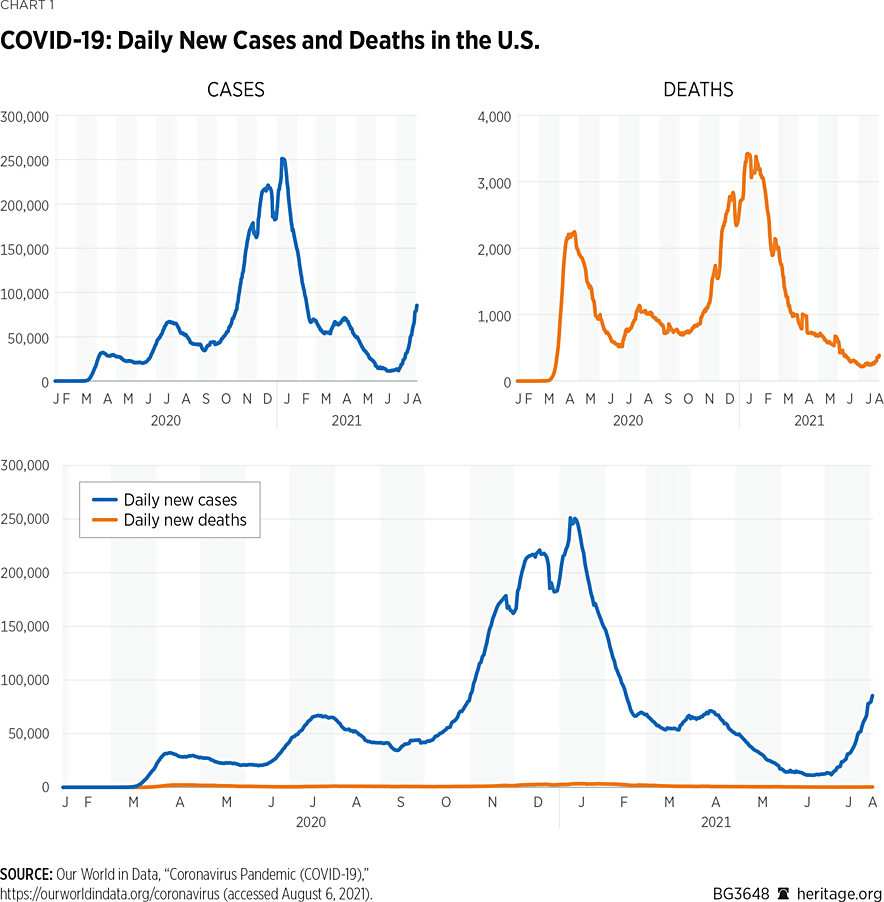
As Chart 1 illustrates, the virus has fluctuated significantly in the United States since early 2020, reaching its highest peak last winter.13
USAFacts.org, “US COVID-19 Cases and Deaths by State,” August 3, 2021, https://usafacts.org/visualizations/coronavirus-covid-19-spread-map/ (accessed August 6, 2021).
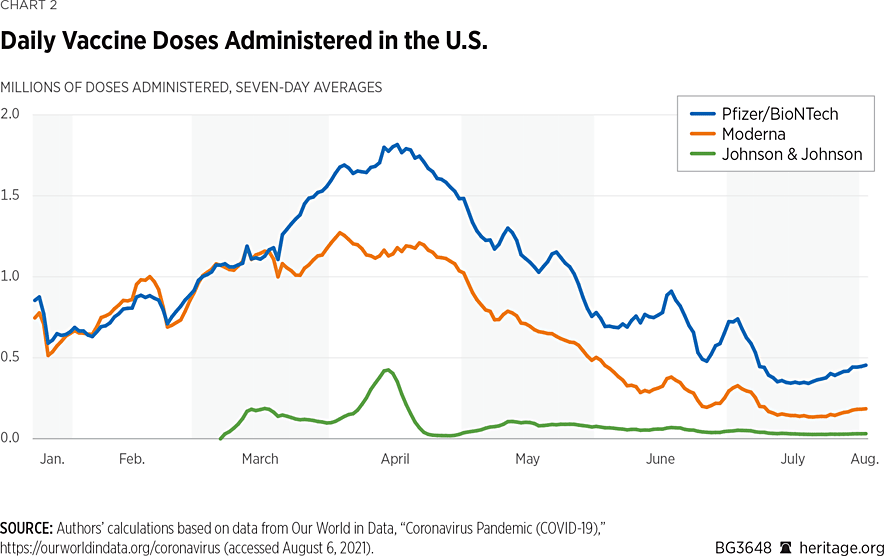
During early 2021, there was tremendous demand for vaccines, with many people having difficulty scheduling appointments and some websites even crashing due to high traffic.14
“Massachusetts Vaccination Scheduling Website Crashes as Appointments Open for 65+,” NBC Boston, February 18, 2021, https://www.nbcboston.com/news/local/nearly-1-million-people-now-eligible-for-covid-vaccine-in-mass/2305907/ (accessed August 4, 2021); Elena Debre, “What’s Up with Coronavirus Vaccines and CVS?” Slate, February 11, 2021, https://slate.com/technology/2021/02/coronavirus-vaccine-pharmacy-rollout.html (accessed August 4, 2021); and Sharon Terlep, “Walgreens Site for Booking Covid-19 Vaccine Crashes,” The Wall Street Journal, March 9, 2021, https://www.wsj.com/articles/walgreens-site-for-booking-covid-19-vaccine-crashes-11615321373 (accessed August 4, 2021).
IHME conducted a statistical analysis of survey data examining attitudes toward vaccine hesitancy across the American population. IHME found that, as of June 10, 2021, over 50 percent of the population was vaccine hesitant, which has likely contributed to the decline. The median hesitancy among all ZIP codes is 19 percent. More than 6,000 ZIP codes have hesitancy above 30 percent, over 580 zip codes have vaccine hesitancy above 50 percent, and 10 zip codes are above 90 percent. See Institute for Health Metrics and Evaluation, “New Tool Shows More Than 50 Percent of the Population Is Vaccine-Hesitant in Over 580 ZIP Codes Across the US,” June 24, 2021, http://www.healthdata.org/news-release/new-tool-shows-more-50-percent-population-vaccine-hesitant-over-580-zip-codes-across-us (accessed August 6, 2021), and Institute for Health Metrics and Evaluation, “Vaccine Hesitancy by County: Jul 09, 2021–Jul 15, 2021,” https://vaccine-hesitancy.healthdata.org/ (accessed August 6, 2021).
Kehinde Eniola and Jean Sykes, “Four Reasons for COVID-19 Vaccine Hesitancy Among Health Care Workers, and Ways to Counter Them,” Quick Tips, A Blog from FPM Journal, April 27, 2021, https://www.aafp.org/journals/fpm/blogs/inpractice/entry/countering_vaccine_hesitancy.html (accessed August 10, 2021).
As Chart 1 demonstrates, COVID-19 cases and deaths declined significantly for much of the first half of 2021 as more Americans were vaccinated. While the U.S. is experiencing a surge in cases due to the Delta variant, most of these cases are among the unvaccinated, and COVID-19 deaths are nowhere near the levels before vaccines were authorized.
Furthermore, as of August 4, 2021, more than 164 million Americans were fully vaccinated against COVID-19, with 191 million people having acquired partial immunity through at least one dose.17
More than 80 percent of Americans 65 and older are fully vaccinated. “See How Vaccinations Are Going in Your County and State,” The New York Times, https://www.nytimes.com/interactive/2020/us/covid-19-vaccine-doses.html (accessed August 4, 2021)
This CDC statistic reflects data as of August 2, 2021. See U.S. Centers for Disease Control and Prevention, “COVID-19 Vaccine Breakthrough Case Investigation and Reporting,” August 2, 2021, https://www.cdc.gov/vaccines/covid-19/health-departments/breakthrough-cases.html (accessed August 8, 2021).
U.S. Centers for Disease Control and Prevention, “COVID-19 Vaccine Breakthrough Case Investigation and Reporting.” Also see Austin Williams, “CDC: Less Than 1% of Breakthrough COVID-19 Cases Led to Hospitalization or Death,” CNN, August 3, 2021, https://www.fox5dc.com/news/cdc-less-than-1-of-breakthrough-covid-19-cases-led-to-hospitalization-or-death (accessed August 5, 2021).
The CDC’s New Public Health Recommendations
As a result of the recent increases in cases due to the Delta variant, the CDC updated its “Interim Public Health Recommendations for Fully Vaccinated People.”20
U.S. Centers for Disease Control and Prevention, “Interim Public Health Recommendations for Fully Vaccinated People.”
- Fully vaccinated people might choose to wear a mask regardless of the level of transmission particularly if they are immunocompromised or at increased risk for severe disease from COVID-19, or if they have someone in their household who is immunocompromised, at increased risk of severe disease, or not fully vaccinated (emphasis added);
- Fully vaccinated people who have come into close contact with someone with suspected or confirmed COVID-19 should be tested three to five days after exposure, and wear a mask in public indoor settings for 14 days or until they receive a negative test result; and
- Universal indoor masking for all teachers, staff, students, and visitors to schools, regardless of vaccination status.21
Ibid.
At the very least, these new guidelines—along with Walensky’s statements—give the impression that the CDC’s new report provides evidence that masks provide better protection than vaccines against contracting COVID-19. The new report simply does not contain such evidence, and the CDC’s latest moves run the risk of increasing vaccine hesitancy. These mixed signals are particularly disturbing because, especially compared to vaccinations, the effectiveness of surgical or cloth masks in meaningfully reducing COVID-19 transmission is not supported by a review of the professional literature. Moreover, evidence shows that mask mandates have done little—if anything—to curb the transmission of the virus and is even less likely to do so compared to vaccinations.22
Although cloth masks have some source control value (they can prevent infected persons from spreading “droplets and particles”), the evidence does not support that wearing cloth masks protect uninfected people from contracting COVID-19. See Doug Badger and Robert E. Moffit, “COVID-19 and Federalism: Public Officials’ Accountability and Comparative Performance,” Heritage Foundation Backgrounder No. 3638, July 26, 2021, https://www.heritage.org/sites/default/files/2021-07/BG3638.pdf. Also see Akriti Nanda et al., “Efficacy of Surgical Masks or Cloth Masks in the Prevention of Viral Transmission: Systematic Review, Meta-Analysis, and Proposal for Future Trial,” Journal of Evidence Based Medicine, February 9, 2021, https://www.ncbi.nlm.nih.gov/pmc/articles/PMC8014575/ (accessed August 5, 2021); Jeffrey H. Anderson, “Do Masks Work?,” City Journal, August 11, 2021, https://www.city-journal.org/do-masks-work-a-review-of-the-evidence (accessed August 12, 2021); Kevin D. Dayaratna and Norbert J. Michel, “A Statistical Analysis of Mandates and Mask Usage in Kansas,” Heritage Foundation Special Report No. 246, April 15, 2021, https://www.heritage.org/sites/default/files/2021-04/SR246.pdf (accessed August 11, 2021); and Kevin D. Dayaratna and Andrew Vanderplas, “A Statistical Analysis of COVID-19 and Government Protection Measures in the U.S.,” Heritage Foundation Special Report No. 243, March 19, 2021, https://www.heritage.org/public-health/report/statistical-analysis-covid-19-and-government-protectionmeasures-the-us.
Interestingly, the CDC’s “Science Brief,”23
U.S. Centers for Disease Control and Prevention, “Science Brief: Community Use of Cloth Masks to Control the Spread of SARS-CoV-2,” May 7, 2021, https://www.cdc.gov/coronavirus/2019-ncov/science/science-briefs/masking-science-sars-cov2.html (accessed August 6, 2021).
The authors report that “[i]nfection with SARS-CoV-2 occurred in 42 participants recommended masks (1.8%) and 53 control participants (2.1%).” Henning Bundgaard et al., “Effectiveness of Adding a Mask Recommendation to Other Public Health Measures to Prevent SARS-CoV-2 Infection in Danish Mask Wearers: A Randomized Controlled Trial,” Annals of Internal Medicine, Vol. 4, No. 3 (November 18, 2020), pp. 335–343, https://pubmed.ncbi.nlm.nih.gov/33205991/ (accessed August 6, 2021). The CDC dismisses these results by claiming that “[f]indings were inconclusive, most likely because the actual reduction in infections was lower,” and that the “study was too small (i.e., enrolled about 0.1% of the population) to assess whether masks could decrease transmission from wearers to others.” See Centers for Disease Control and Prevention, “Science Brief: Community.” Neither of these critiques is valid—it is improper to dismiss the results because the “reduction in infections was lower,” and it is unequivocally not the case that a sample can be dismissed as “too small” because it fails to meet an arbitrary threshold of the population.
The CDC “Study” of Barnstable County, Massachusetts
The CDC based its new recommendations on a July 30 Morbidity and Mortality Weekly Report (MMWR) article.25
Brown et al., “Outbreak of SARS-CoV-2 Infections.”
Since the CDC’s study was published, new cases were linked to the festivities and reported to the Barnstable County Department of Health. This update is addressed further in the next section of this Backgrounder.
Amongst the estimated 60,000 people who visited the area, these figures represent 0.008 percent of the attendees who were hospitalized, and a mortality rate of zero.
Brown et al., “Outbreak of SARS-CoV-2 Infections,” p. 2.
Beyond reporting these statistics, the MMWR provides little additional information other than discussing key limitations to the data. One key limitation is that the qualitative results “might mean that the viral load of vaccinated and unvaccinated persons infected with SARS-CoV-2 is also similar,” but that “microbiological studies are required to confirm these findings.”29
Ibid., p. 4. There is much debate regarding whether similar viral loads in the vaccinated and unvaccinated imply that both groups are just as contagious. Robbie Whelan and Jared S. Hopkins, “CDC’s Covid-19 Mask Guidance Clouded by Flawed Data,” The Wall Street Journal, August 3, 2021, https://www.wsj.com/articles/cdcs-covid-19-mask-mandate-clouded-by-flawed-data-11627983001 (accessed August 4, 2021).
The MMWR acknowledges that asymptomatic infections are likely underrepresented in the data, and that “demographics of cases likely reflect those of attendees at the public gatherings.”30
Brown et al., “Outbreak of SARS-CoV-2 Infections,” p. 3.
While the authors claim that “further study is underway” to collect additional demographic information on those who were infected, they also report that 30 of the people who contracted COVID-19 are also HIV positive. Ibid.
It is a mistake, therefore, to project these results onto the general U.S. population, or even to a randomly selected person who attended the festivities in Barnstable. It would be grossly irresponsible, for example, to use the data in the MMWR to suggest that the typical vaccinated American has similar chances of contracting COVID-19—much less becoming severely ill from such an occurrence—to those of someone who is not vaccinated. Indeed, it is completely unsurprising that the authors include the following disclaimer: “data from this report are insufficient to draw conclusions about the effectiveness of COVID-19 vaccines against SARS-CoV-2, including the Delta variant, during this outbreak.”32
Brown et al., “Outbreak of SARS-CoV-2 Infections,” p. 3.
The only mystery is why the MMWR includes this language:
Findings from this investigation suggest that even jurisdictions without substantial or high COVID-19 transmission might consider expanding prevention strategies, including masking in indoor public settings regardless of vaccination status, given the potential risk of infection during attendance at large public gatherings that include travelers from many areas with differing levels of transmission.33Ibid., p. 1.
The MMWR does not, in any way, provide statistical evidence for these recommendations: There was no investigation of these prevention strategies—none—among the vaccinated or unvaccinated. In fact, given the underlying data, it is difficult to see how including this sentence in the MMWR could do anything other than mislead the public and unnecessarily spread fear.
Potential Positivity Rates and Hope
Since the publication of the MMWR, new cases were linked to the festivities and reported to the Barnstable County Department of Health. As of July 29, the total number of confirmed COVID-19 cases was 934, with 560 cases from the state of Massachusetts. The data indicates that 73 percent of the Massachusetts residents who tested positive were vaccinated, but the health department does not (or is unable to) specify the vaccination rate of all positive cases after including out-of-state visitors.34
Barnstable County Department of Health and Environment, “July 30, 2021, Update: COVID-19 Cluster in Provincetown,” July 30, 2021, https://www.barnstablecountyhealth.org/newsroom/july-30-2021-update-covid-19-cluster-in-provincetown (accessed August 6, 2021).
As alluded to in the previous section, the MMWR fails to provide any context regarding how many people who attended the festivities (or the general population) in Barnstable were fully vaccinated.35
The MMWR does claim that 69 percent of eligible Massachusetts residents are vaccinated.
The first piece of information needed is the number of people who attended the festivities. While it is impossible to know that figure with certainty, at least two public estimates suggest that approximately 60,000 people attended the events in Barnstable.36
Marianne Guenot, “24 Vaccinated Friends Had a Blowout Vacation on Cape Cod. Though Their Symptoms Were Mild, 14 of Them Caught COVID-19, Report Says,” Business Insider, August 2, 2021, https://www.businessinsider.com/party-cape-cod-l14-vaccinated-friends-covid-19-provincetown-cdc-2021-8 (accessed August 4, 2021), and Ingu Yun, “The Provincetown Covid Data Is Actually Good News (If You Are Vaccinated),” Medium, August 1, 2021, https://inguyun.medium.com/the-provincetown-outbreak-is-actually-good-news-if-you-are-vaccinated-93a1edd763b6 (accessed August 4, 2021).
According to The New York Times, the State of Massachusetts and Barnstable County have adult vaccination rates of 74.8 percent and 76 percent, respectively.37
These statistics assume full vaccination. “See How Vaccinations Are Going in Your County and State,” The New York Times, August 3, 2021, https://www.nytimes.com/interactive/2020/us/covid-19-vaccine-doses.html (accessed August 4, 2021).
“Town-by-Town COVID Vaccination Rates,” CBS Boston, July 22, 2021, https://boston.cbslocal.com/town-by-town-covid-vaccination/ (accessed August 4, 2021).
Yun, “The Provincetown Covid Data Is Actually Good News.”
To derive a base estimate, we assume an overall vaccination rate of 90 percent, among 60,000 attendees of the public gatherings in Barnstable, along with a vaccination rate of 70 percent among the positive cases. These assumptions result in positivity rates of 1.21 percent for the vaccinated, and 4.67 percent for the unvaccinated. (See Table 1.)
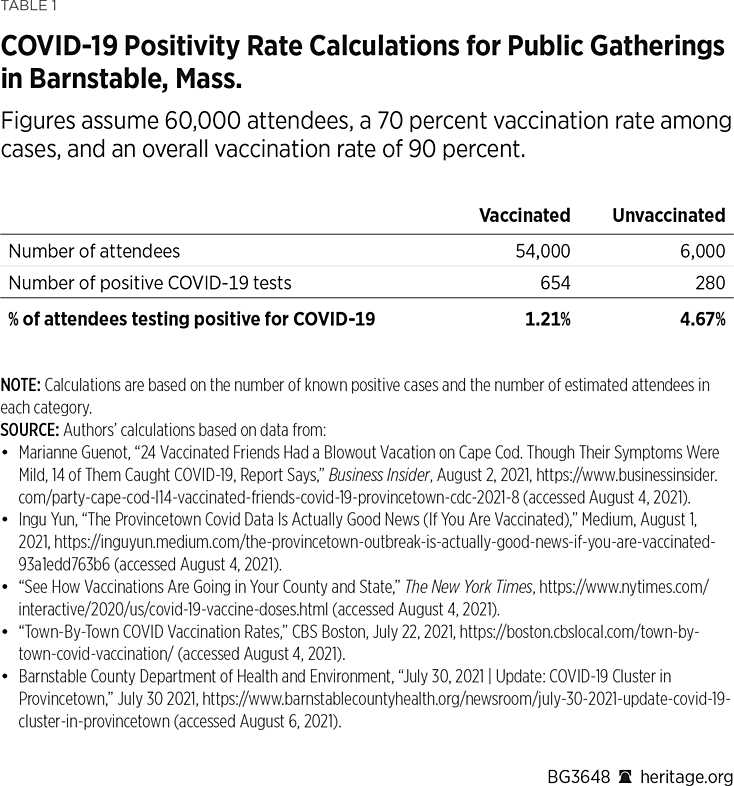
That is, assuming a 90 percent vaccination rate, only 1.21 percent of the estimated 54,000 vaccinated attendees, and 4.67 percent of the estimated 6,000 unvaccinated, tested positive for COVID-19. Of course, the festivities had many out-of-town visitors, making it difficult to ascertain the true vaccination rate among attendees. Therefore, we estimate positivity rates for a range of vaccination coverage. Chart 3 presents positivity-rate estimates with vaccine rates ranging from 60 percent (the national adult vaccination rate40
“See How Vaccinations Are Going in Your County and State,” The New York Times, August 3, 2021.
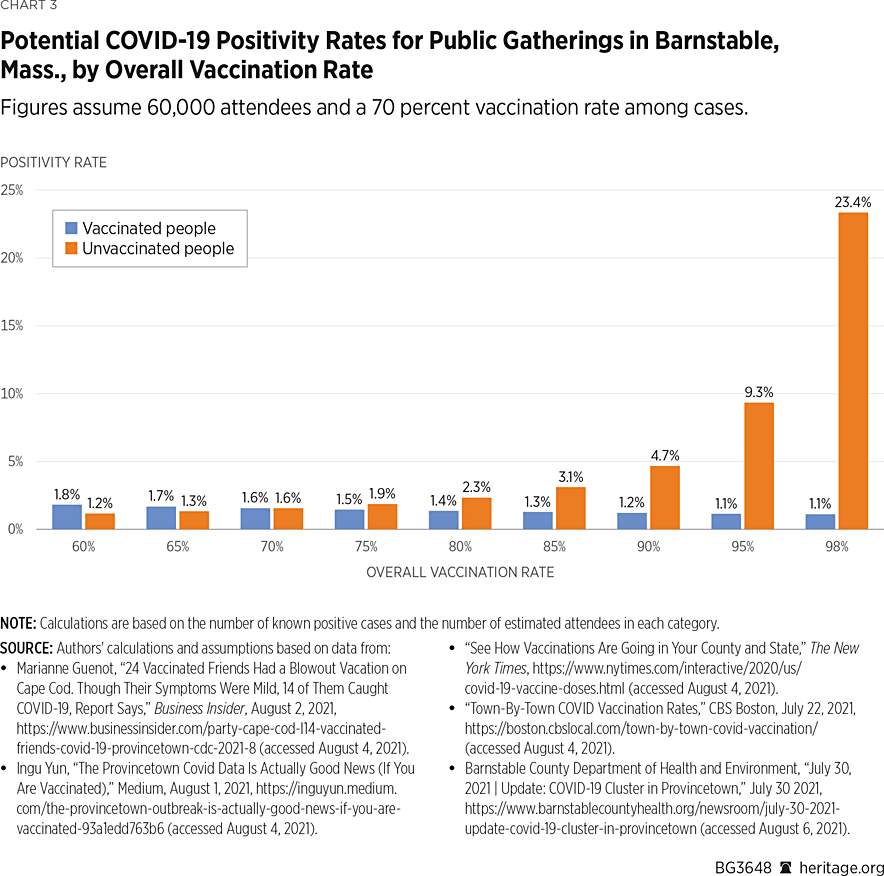
As Chart 3 illustrates, under all such assumptions, the percentage of the breakthrough cases (associated with the Barnstable festivities) among the vaccinated is less than 2 percent of the estimated population of attendees. The MMWR provides no such analysis, thus omitting critical context for how COVID-19 might spread among the vaccinated. Thus, headlines, such as “74 Percent of People Infected in Massachusetts Covid Outbreak Were Fully Vaccinated,” are highly misleading and risk needlessly creating panic.41
Lovelace Jr., “CDC Study Shows 74% of People Infected in Massachusetts Covid Outbreak Were Fully Vaccinated.”
It is true that 74 percent of the attendees who later reported contracting COVID-19 were fully vaccinated, but that figure, under the assumptions made in Chart 3, represents—at most—less than 2 percent of the attendees. More important, out of these 133 COVID-19 patients who had the Delta variant, five were hospitalized (0.008 percent of the estimated attendees) and not a single person died.42
Newer reports indicate more than 900 cases, with seven hospitalizations and no deaths. Carey Goldberg and Nic Querolo, “In Provincetown, Covid Hits 14 Friends in Show of Delta’s Might,” Bloomberg, August 1, 2021, https://www.bloomberg.com/news/articles/2021-08-01/in-provincetown-14-friends-nab-covid-in-show-of-delta-s-might (accessed August 5, 2021).
According to the CDC’s most recent data on breakthrough cases (those where a fully vaccinated person contracts COVID-19), of more than 164 million fully vaccinated Americans, there have been 7,101hospitalizations and 1,507 deaths.43
U.S. Centers for Disease Control and Prevention, “COVID-19 Vaccine Breakthrough Case Investigation and Reporting.”
Ibid.
Vaccines clearly provide substantial protection against COVID-19—among the fully vaccinated, these figures represent 0.003 percent hospitalized and 0.0007 percent deaths. These percentages indicate that the odds of a fully vaccinated person being hospitalized due to COVID-19 are approximately 1 in 31,000, while the odds of dying are 1 in 137,000. To better put these odds in perspective, it is useful to examine the odds of various causes of death published by the National Safety Council.
Alternative Causes of Death. Sadly, people die each year. In 2019, the National Safety Council used data from the National Center for Health Statistics to estimate the odds of various lifetime causes of death, including (among others) heart disease, cancer, pedestrian incidents, and drowning. Heart disease, cancer, and other chronic lower respiratory diseases constituted some of the highest causes of death in 2019 (with odds of 1 in 6, 1 in 7, and 1 in 27, respectively).
There were many other causes of death albeit occurring at much lower frequencies. For example, motor vehicle crashes were associated with a 1 in 103 odds of dying, gun assaults were associated with a 1 in 289 odds of dying, and hornet wasp and bee stings were associated with a 1 in 59,507 odds of dying.45
NSC Injury Facts, “Preventable Deaths: Odds of Dying,” https://injuryfacts.nsc.org/all-injuries/preventable-death-overview/odds-of-dying/ (accessed August 4, 2021).
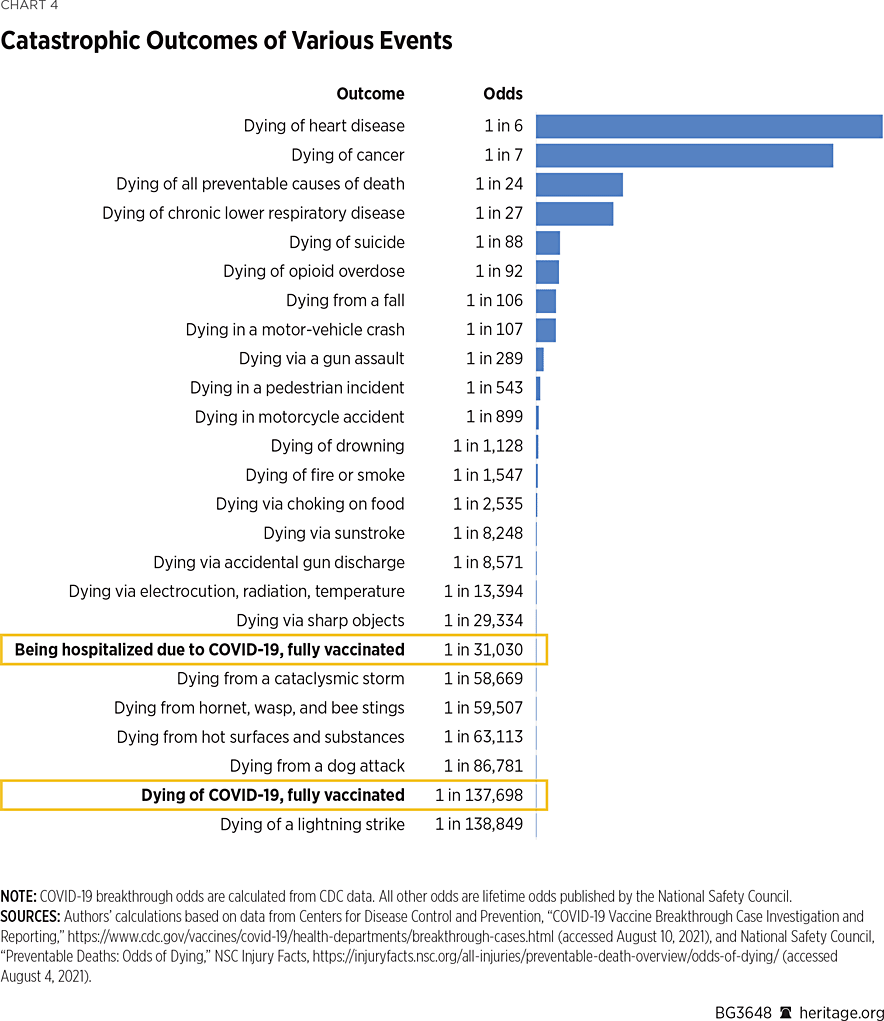
As Chart 4 illustrates, typical causes of death, such as heart disease, cancer, and chronic lower respiratory diseases are still more likely to take people’s lives than a breakthrough case of COVID-19. In fact, the odds of dying of COVID-19 after being fully vaccinated are lower than getting killed in a dog attack or getting killed by a swarm of bees. In fact, as Chart 4 illustrates, the odds of dying of COVID-19 after being fully vaccinated are comparable to dying by lightning strike.
For the elderly unvaccinated, and the unvaccinated with chronic health conditions, COVID-19 is still quite deadly, as has been discussed extensively in prior Heritage Foundation research.46
Kevin D. Dayaratna and Andrew Vanderplas, “A Statistical Analysis of COVID-19 and Government Protection Measures in the U.S.,” Heritage Foundation Special Report No. 243, March 19, 2021, https://www.heritage.org/public-health/report/statistical-analysis-covid-19-and-government-protection-measures-the-us (accessed August 4, 2021), and Kevin D. Dayaratna, Patrick Tyrrell, and Andrew Vanderplas, “A Comparative Analysis of Policy Approaches to COVID-19 Around the World, with Recommendations for U.S. Lawmakers,” Heritage Foundation Special Report No. 234, July 20, 2020, https://www.heritage.org/public-health/report/comparative-analysis-policy-approaches-covid-19-around-the-world.
Prior Heritage Foundation research has also noted that COVID-19 is also quite dangerous for the chronically ill regardless of age group. See Dayaratna and Vanderplas, “A Statistical Analysis of COVID-19 and Government Protection Measures in the U.S.”
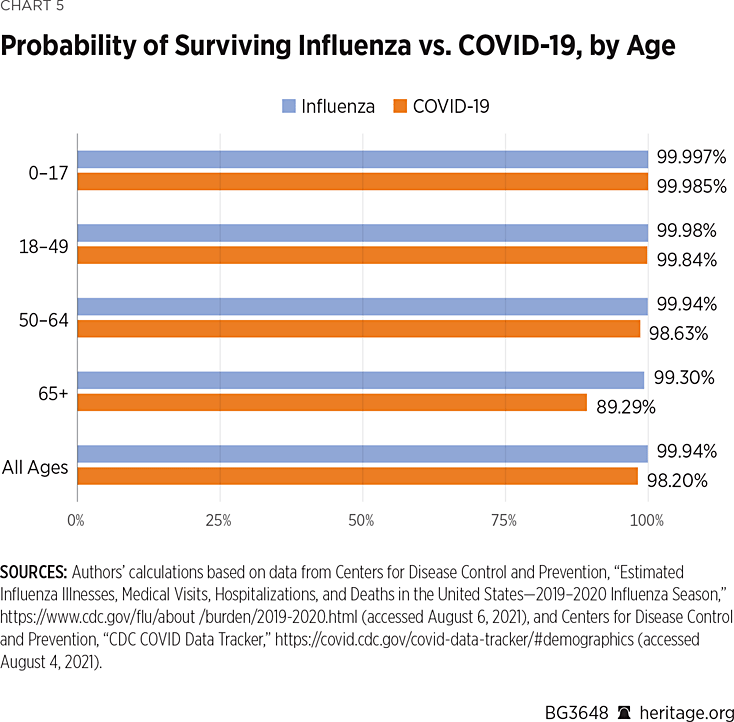
While vaccines for COVID-19 do not provide 100 percent protection against infection or death, neither do many other vaccines, including the influenza vaccine.48
U.S. Centers for Disease Control and Prevention, “Vaccines and Preventable Diseases,” https://www.cdc.gov/vaccines/vpd/vaccines-diseases.html (accessed August 6, 2021).
USAFacts.org, “How Many Americans Get Flu Shots?” 2021, https://usafacts.org/articles/how-many-americans-get-flu-shots-vaccine-cdc/ (accessed August 5, 2021), and U.S. Centers for Disease Control and Prevention, “Estimated Influenza Illnesses, Medical Visits, Hospitalizations, And Deaths In The United States—2018–2019 Influenza Season,” January 8, 2020, https://www.cdc.gov/flu/about/burden/2018-2019.html (accessed August 5, 2021).
U.S. Centers for Disease Control and Prevention, “Vaccine Effectiveness: How Well Do the Flu Vaccines Work?” May 6, 2021, https://www.cdc.gov/flu/vaccines-work/vaccineeffect.htm (accessed August 5, 2021).
Policy Implications
More than one year after the COVID-19 pandemic started in the U.S., a wealth of data is now available to policymakers and the public. It is critical that government officials rely on this evidence and stop politicizing public health issues. At the very least, officials should follow these two recommendations. Officials should:
- Promote vaccines, not mask mandates. The evidence shows that vaccines provide significant protection against serious illness or death from the virus, including the Delta variant. The evidence also shows that mask mandates do not meaningfully curb disease proliferation. Lawmakers should therefore focus on encouraging the vaccine hesitant to get vaccinated rather than requiring the already vaccinated to wear masks. Mask mandates, particularly for the vaccinated, will likely discourage the unvaccinated from reconsidering, and thus prolong the pandemic.
- Focus on the data and ensure that they are presented accurately. The CDC and other government agencies should make more data about breakthrough cases publicly available and present them in the context of the overall fully vaccinated population, not self-selected non-random samples. As of now, the CDC does not provide detailed COVID-19 breakthrough data by age category as they do for overall infections. Given the small total number of such cases, releasing such data every week may not be informative. Nonetheless, officials have a duty to avoid politicizing COVID-19 by presenting data accurately and responsibly.
Conclusion
COVID-19 is a highly communicable disease that spreads rapidly, even in communities under lockdown orders.51
Dayaratna, Tyrrell, and Vanderplas, “A Comparative Analysis of Policy Approaches to COVID-19 Around the World.”
According to CDC estimates, the Delta variant represented more than 80 percent of new U.S. COVID-19 cases at the end of July 2021. Unfortunately, the CDC has done a poor job of using evidence to calm the public’s fears throughout the pandemic, and its latest public health guidelines for the fully vaccinated are no exception to that rule.
CDC Director Walensky announced these new guidelines based on data that allegedly imply that the vaccines offer little protection against the Delta variant. However, the CDC report fails to support this conclusion. In fact, the authors of the CDC report provide an explicit warning: “[D]ata from this report are insufficient to draw conclusions about the effectiveness of COVID-19 vaccines against SARS-CoV-2, including the Delta variant, during this outbreak.”52
Brown et al., “Outbreak of SARS-CoV-2 Infections,” p. 3.
Despite the CDC’s misuse of the data in the new report, the overall evidence remains clear: Vaccines for COVID-19 have provided people with significant protection against serious illness or death from the virus, including the Delta variant. Public health guidelines should reflect this reality.
Kevin Dayaratna, PhD, is Principal Statistician, Data Scientist, and Research Fellow in the Center for Data Analysis, of the Institute for Economic Freedom and Opportunity, at The Heritage Foundation. Norbert J. Michel, PhD, is Director of the Center for Data Analysis.
https://www.heritage.org/public-health/report/statistical-analysis-covid-19-breakthrough-infections-and-deaths?gclid=CjwKCAjw5c6LBhBdEiwAP9ejG0Mww-lD_GgOSeyjp3xw5o9esZ12jEm4fAefy6LTn4EZHQDGuxtUpRoCwcYQAvD_BwE
No comments:
Post a Comment